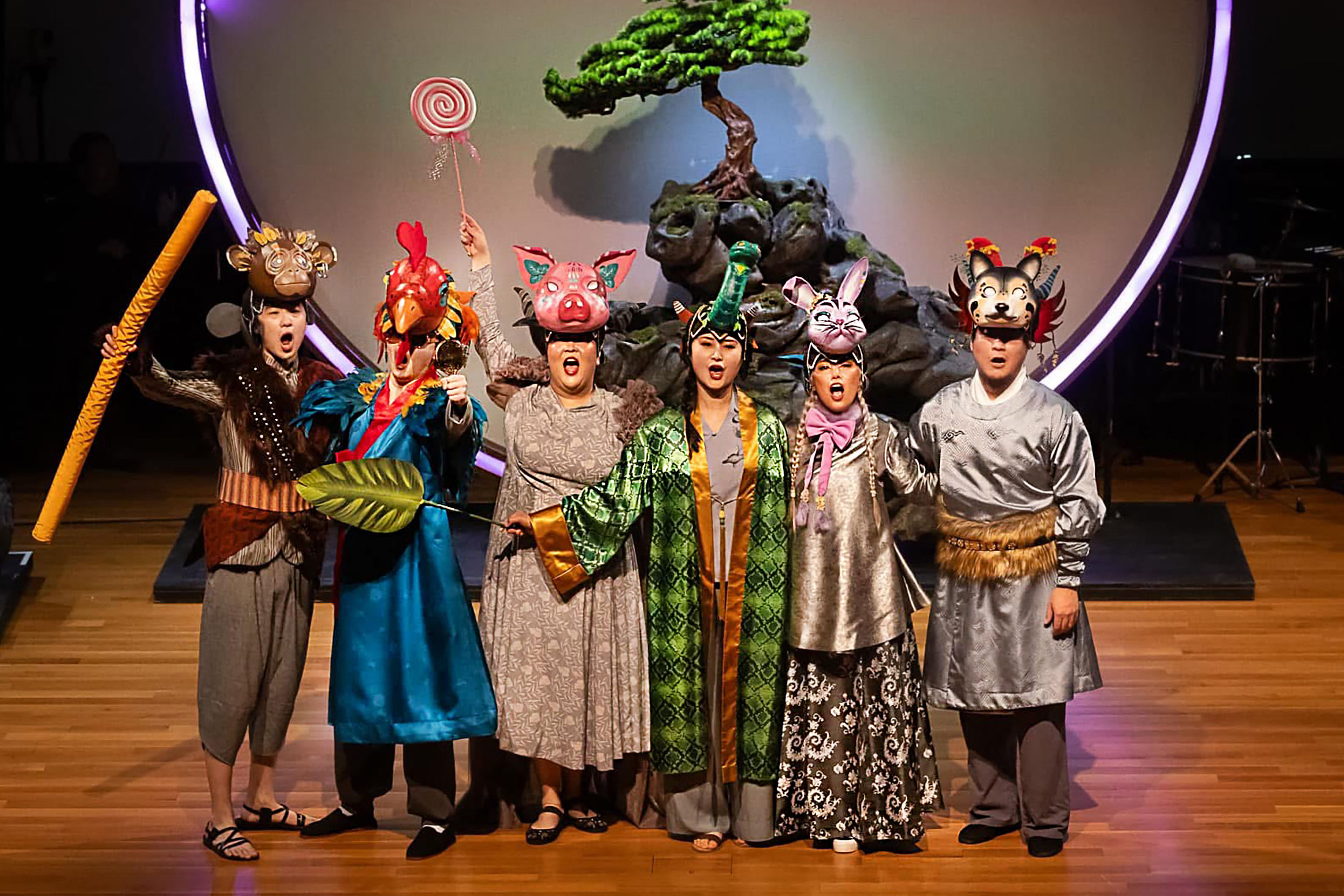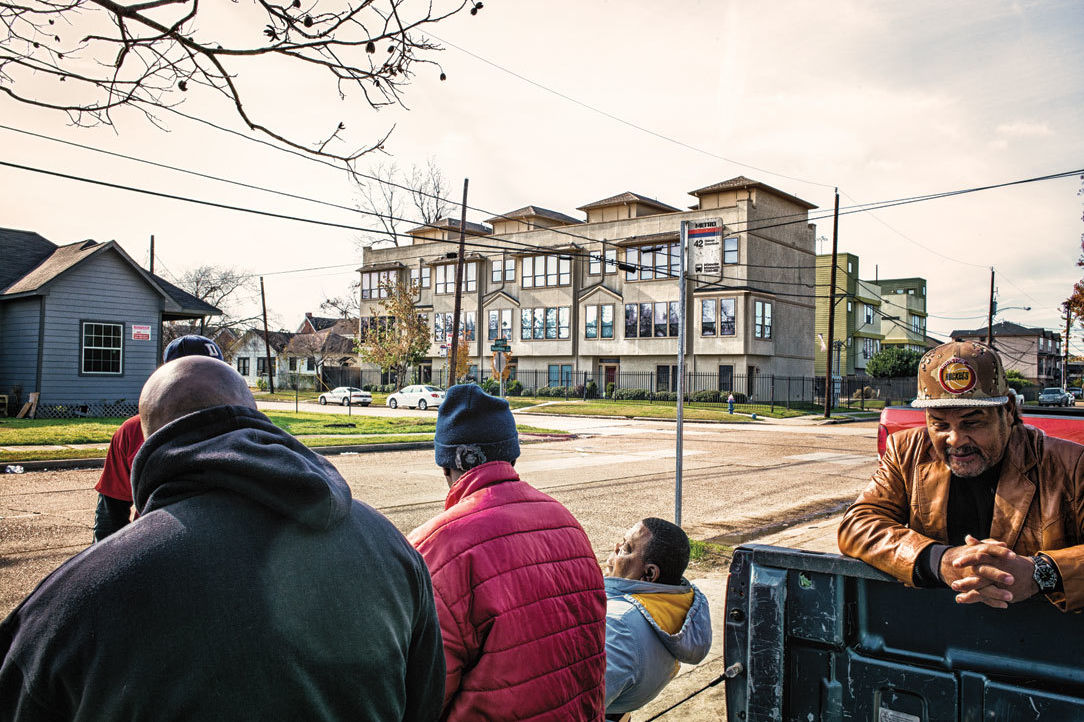
Along Holman Street, the Past, Present, and Future of the Third Ward
It begins above Highway 288, on a rise offering a spectacular view of the downtown skyline, and stretches east for just over a mile, dead-ending on the verdant, shape-shifting campus of the University of Houston. Walking the length of Holman St. takes just 30 minutes, but in that time there’s no limit to the stories you’ll hear. Expensive new townhomes give way to modest single-family bungalows, which give way to trash-strewn lots patrolled by drug dealers, which give way to churches and more single-family houses. That’s the real estate story.
But Holman also tells another tale, one that began in the years after the Civil War, when emancipated slaves from across the Gulf Coast region moved to the Third Ward. To walk Holman today is to be reminded of the landmark achievements of the 1920s, when the city’s first college for African Americans—which became Texas Southern University—was founded, and the neighborhood’s rich cultural tradition of the ’40s and ’50s, when Count Basie and Ray Charles played the Eldorado Ballroom on Elgin Blvd. One sees that the second half of the 20th century left its mark too, especially the one-two punch of deindustrialization and the war on drugs, which forced many middle-class black families to leave the area, and many locally owned businesses to close.
But the story doesn’t end there. Abundant signs of the Third Ward’s recent resurgence can also be seen, in the Holman shotgun houses restored and repurposed by artist Rick Lowe, whose Project Row Houses community art initiative has received national attention, and in a $300 million building campaign at UH that has already produced a new football stadium and student center.
Not surprisingly, the area’s revival has proved attractive to a new population lured by its affordable prices and proximity to downtown. This too is a familiar story, at least to some, one of longtime residents being priced out of their homes and a neighborhood identity under siege. To others it is a more hopeful narrative, one in which new investment will bring much-needed change to an area still lacking in many essential services.
Holman Street is full of stories. You just have to listen.
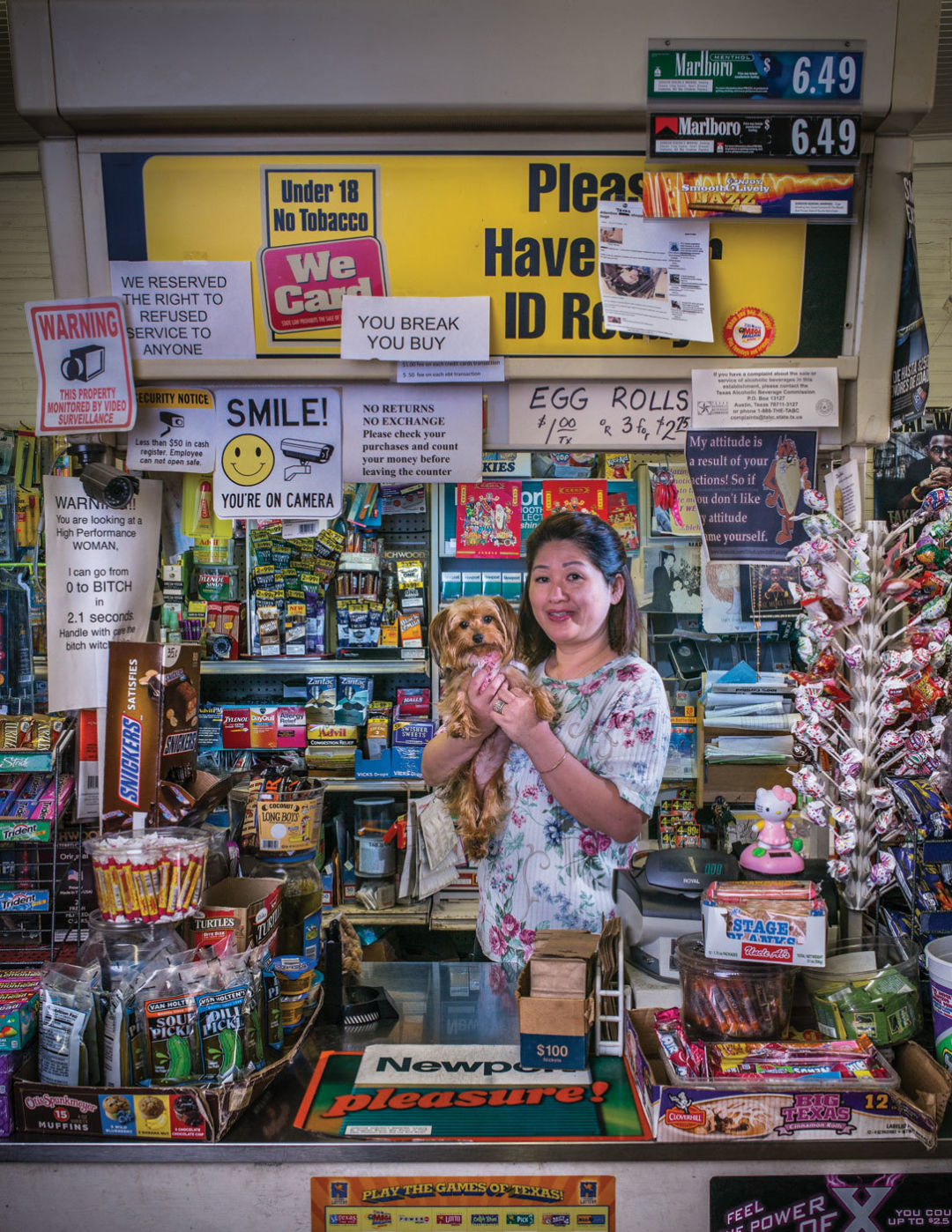
Kim Tran
Store Owner
A sign on the door of the Tulson Corner Mart on the corner of Holman and Burkett St. says “No Masks, No Hoodies, No Costumes.” Inside, 49-year-old Kim Tran is behind the cash register playing with her three Yorkies, occasionally craning her head to watch a Vietnamese soap opera on a flat-panel television above the entrance. The register is wreathed in more warning signs: “You Break You Buy”; “I Can Go From 0 to Bitch in 2.1 Seconds.” Customers wait in line to buy candy, beer, cigarettes, lottery tickets. They call Tran by name, ask how she’s doing. She inquires about their families.
The corner store has been here since Tran’s parents, Vietnamese immigrants, opened it in 1983. She grew up in Jersey Village but spent countless weekends in the Third Ward helping her parents out at the store. In 2001, her mother died of asthma, and later that year her father was shot and killed at Tulson during an armed robbery. The store closed and remained shuttered for seven years. Then, in 2008, Tran and her husband decided to reopen. They bought a home down the street to be closer to the community, remodeled the store to make it more secure, and built a shrine to Tran’s father in a back corner.
In the years since, Tran has been robbed several times—sometimes by masked criminals whose voices she recognized—but she hasn’t feared for her safety except during a six-month stretch when her husband was working on an oil rig and a policeman escorted her home each night. Tulson isn’t the easiest store to run, she says, but the Third Ward is her home, and she intends to stay. “We’ve seen these kids grow up. I’ve taken some under my wing, because I don’t have any children, and a lot of them don’t have parents who are involved. It’s become a community.”
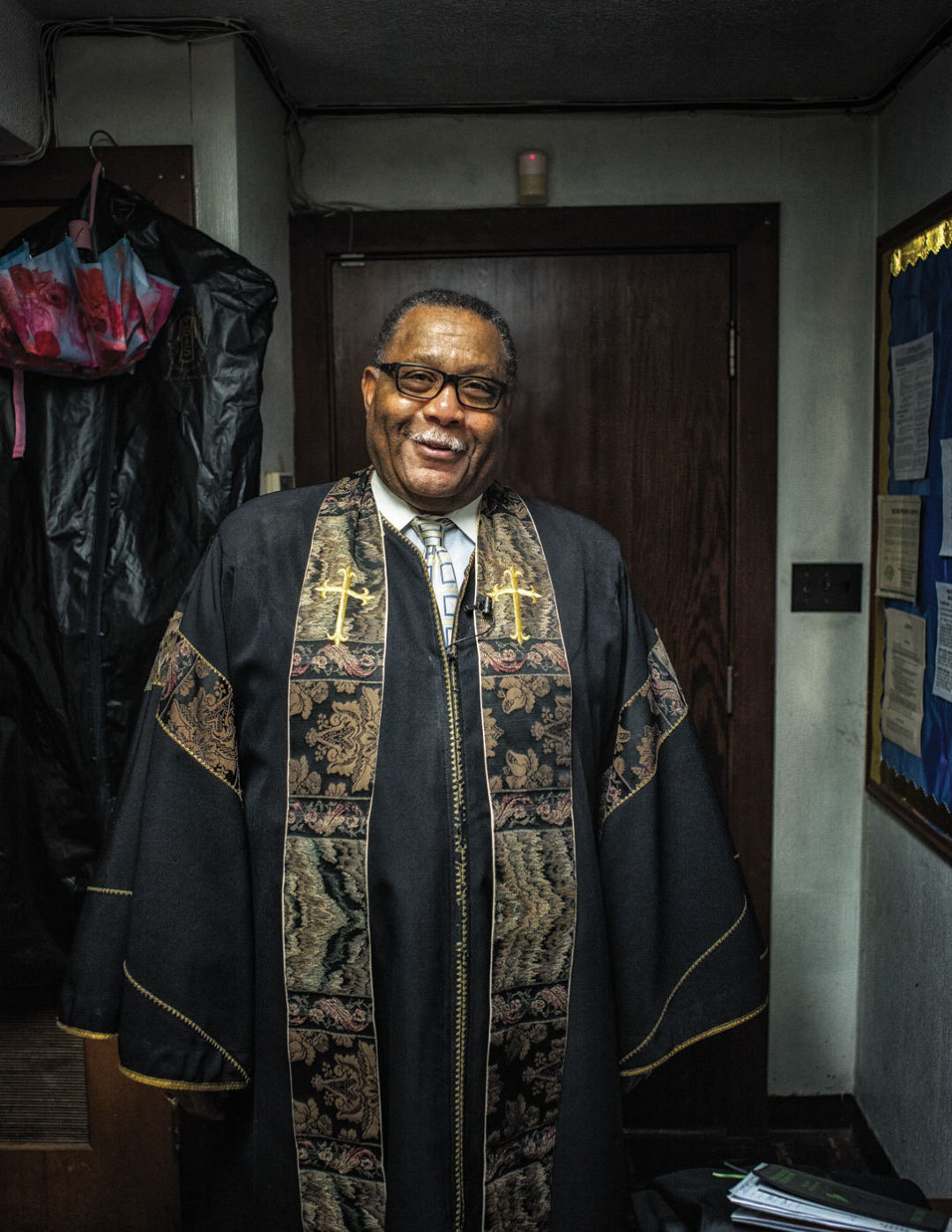
Robert McGee
Pastor
This month, Trinity United Methodist Church at Holman and Live Oak St. celebrates its 150th anniversary, which makes it one of the oldest African American congregations in Houston. Founded shortly after the end of the Civil War by preacher Elias Dibble and a few parishioners, Trinity started life in a private house north of Buffalo Bayou. The church occupied a succession of downtown buildings until 1949 when it moved into its current home in the Third Ward. Many families have been attending the church for generations, and everyone seems to know everyone else at Sunday morning services.
Robert McGee grew up in Sealy, studied theology at the Gammon Theological Seminary, and has been Trinity’s senior pastor for the past 26 years. He takes particular pride in the number of educators who have been members of the church’s congregation over its long history, noting that 18 schools in Houston are named after parishioners. These days, many of those parishioners have, like McGee, left the Third Ward for greener pastures, returning only to attend church or volunteer in one of the church’s many community programs.
McGee sees an opportunity in the development boom. Although some of the new arrivals have visited Trinity, none have become members—yet. Over the past year, McGee has been strategizing with church members about how to bring some of their new neighbors into the fold. “I don’t want Trinity to be just an African American church,” he says. “Yeah, we’re African American, but I’m looking for ways to embrace other cultures. I’ve posed the question, ‘What if we had 10 white families come and be a part of our church? How would y’all feel if you looked up and there were 10, 20 white families?’ They say, ‘Oh, we’re not going to let them take over.’ But I say, ‘They want to be a part! We won’t be friends with them?’”
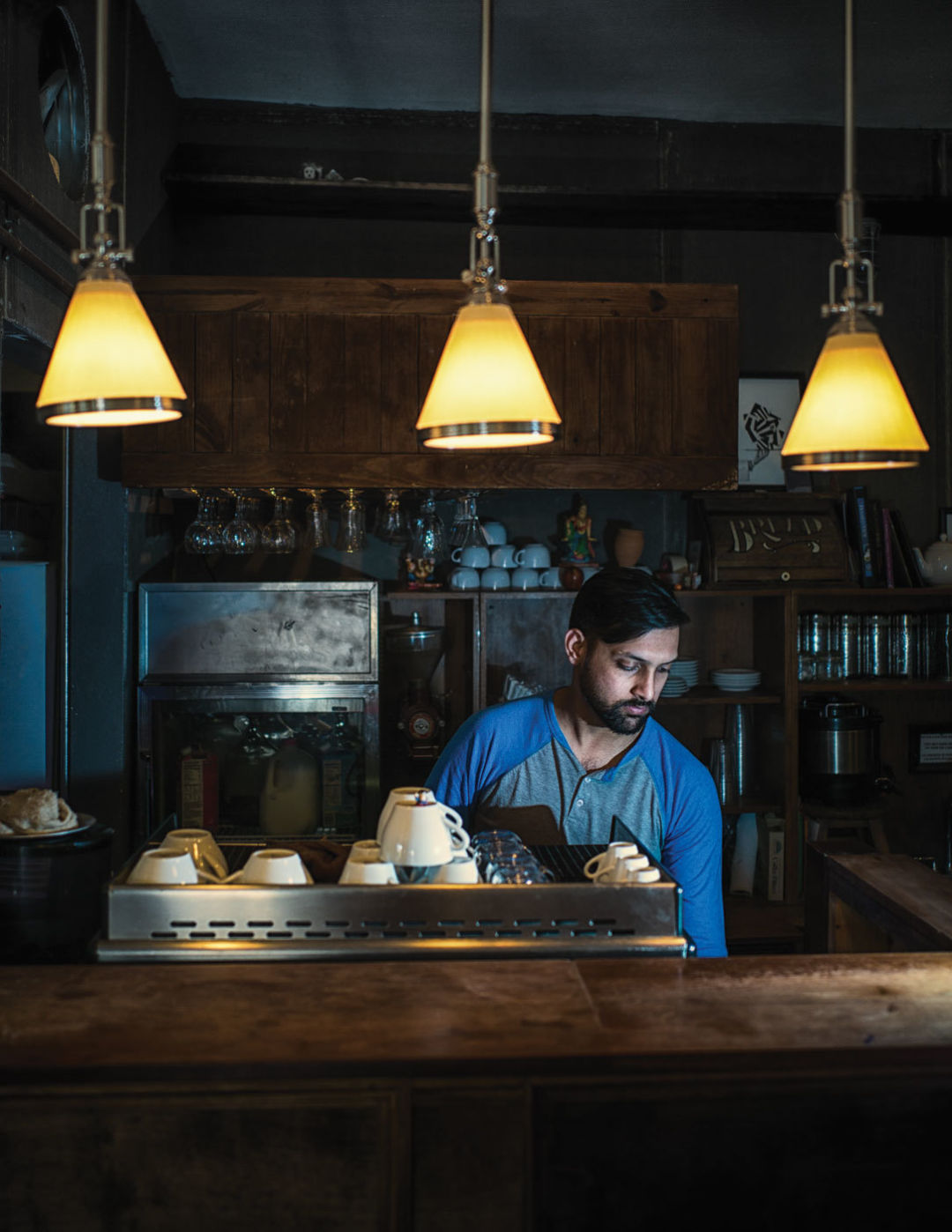
Deepak Doshi
Café Owner
In 2008, Deepak Doshi was working as a district manager at PepsiCo when he drove past an old, condemned building on the corner of Holman and Dowling St. He’d already been thinking about quitting his job to start an art gallery or café, and this seemed the perfect location—next door to Project Row Houses, across Highway 288 from Midtown, and within walking distance of all the new townhouses that were going up. The 1936 structure had previously housed a law office, a medical supply store, a meat market, and a liquor store, although it seemed fated for a date with a bulldozer by the time Doshi saw it.
Instead, two years later it reopened as an art gallery that sold moderately priced work by neighborhood artists. In 2012 the gallery—Doshi House—began serving coffee, tea, and vegetarian/vegan food, a first for the neighborhood. “I saw an opportunity to open a business because there was nothing there,” he explained. “What I wasn’t sure about was the response, especially with it being a vegetarian, vegan, health-conscious concept. Traditionally, the stores here are not any of those things.”
Today, Doshi House serves up a glimpse of the area’s changing demographics as well—UH grad students knitting on couches across from scruffy hipster types sipping chai and pecking on MacBooks. While we were there, Rick Lowe, he of the adjacent Project Row Houses and recent recipient of a MacArthur “genius” grant, popped in to say hello to a few people, Doshi included.
With a major building expansion in the works, it’s fair to call the café a success story. But that doesn’t mean there haven’t been challenges. When Doshi opened the place, he didn’t want to use iron bars on the windows like so many other area stores, instead installing bulletproof glass. Just a week after a sign went up announcing that he was applying for a liquor license, however, thieves managed to smash open a window and ransack the store. Of course, there was no alcohol on hand—Doshi hadn’t received the license yet—so they left empty-handed. “They didn’t even take a sandwich,” he said, laughing and shaking his head.
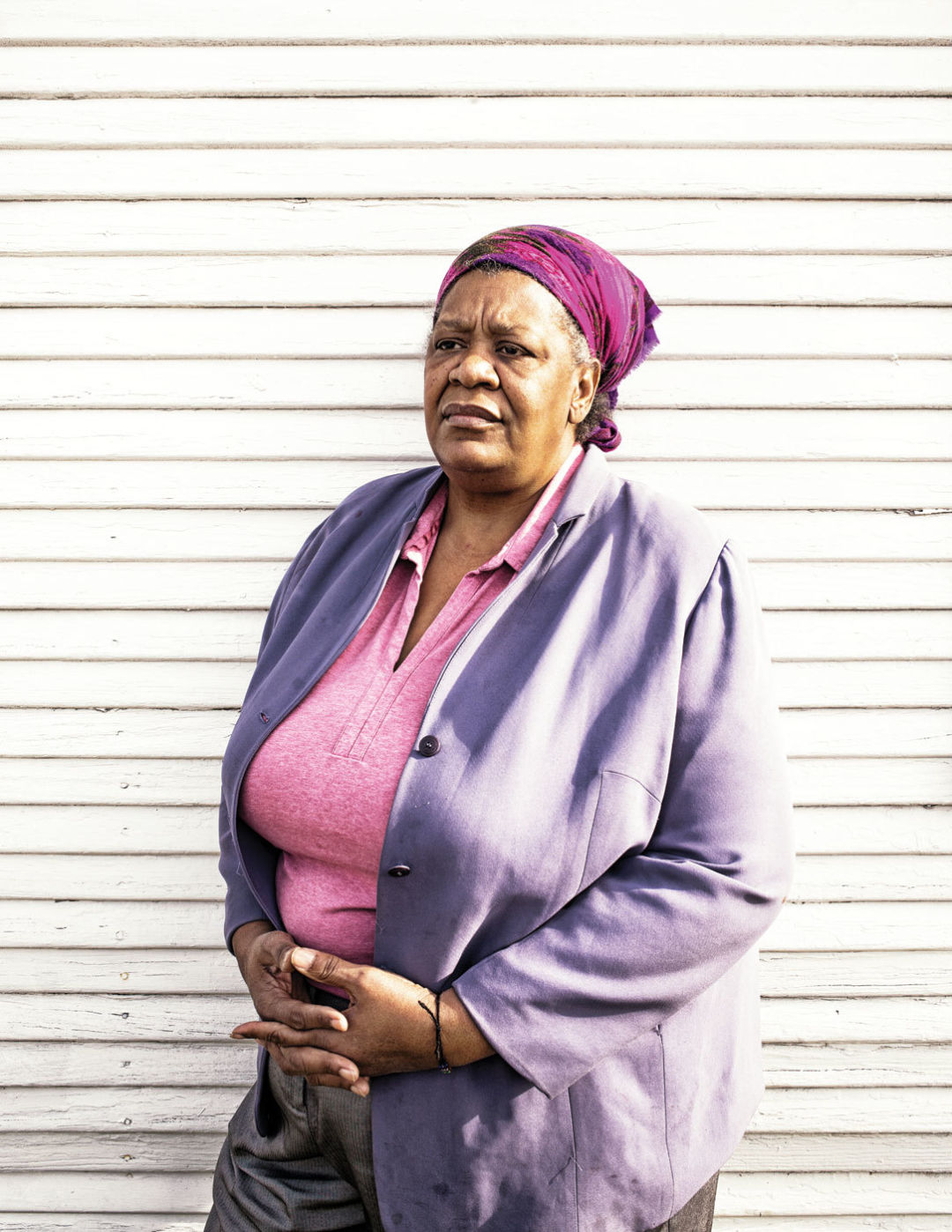
P.K. McCary
Mentor
On a recent afternoon, on the grass outside the Project Row Houses complex on Holman and St. Charles St., an imposing woman with a brightly colored headscarf was teaching a teenager from Pearland named Terrence how to cut a section of canvas from a large roll spread out on the ground. Looking on was artist Jesse Lott, a bearded man with crooked teeth and a quick laugh. The pair was making a large banner for a rally against police brutality at the State Capitol in Austin. And leading the effort was P.K. McCary, who for the last two years has been a Project Row Houses Teaching Artist in Residence, which gives her access to one of the shotgun-style houses to use as she wishes.
McCary has transformed her house into a homey boutique that sells work by local artists, as well as a space for mentoring young artists-in-the-making like Terrence. “I do two things that young people like—feed them and listen to them,” McCary said. “Those are two of the most important aspects of working with young people. I think that’s the gift I bring. They know I’m listening, and they know they’re being heard.” McCary also uses her background in marketing to help local artists advertise and sell their work.
“Nonprofits use artists, but they don’t necessarily pay them. And I want my artists to learn the value of their work.” In keeping with Project Row Houses’ legacy of political activism, McCary also insists that any work she sponsors have a social justice component—hence her work with Lott on the protest banner. “They call me the Peacekeeper,” McCary said. “And I do think art is peace.”
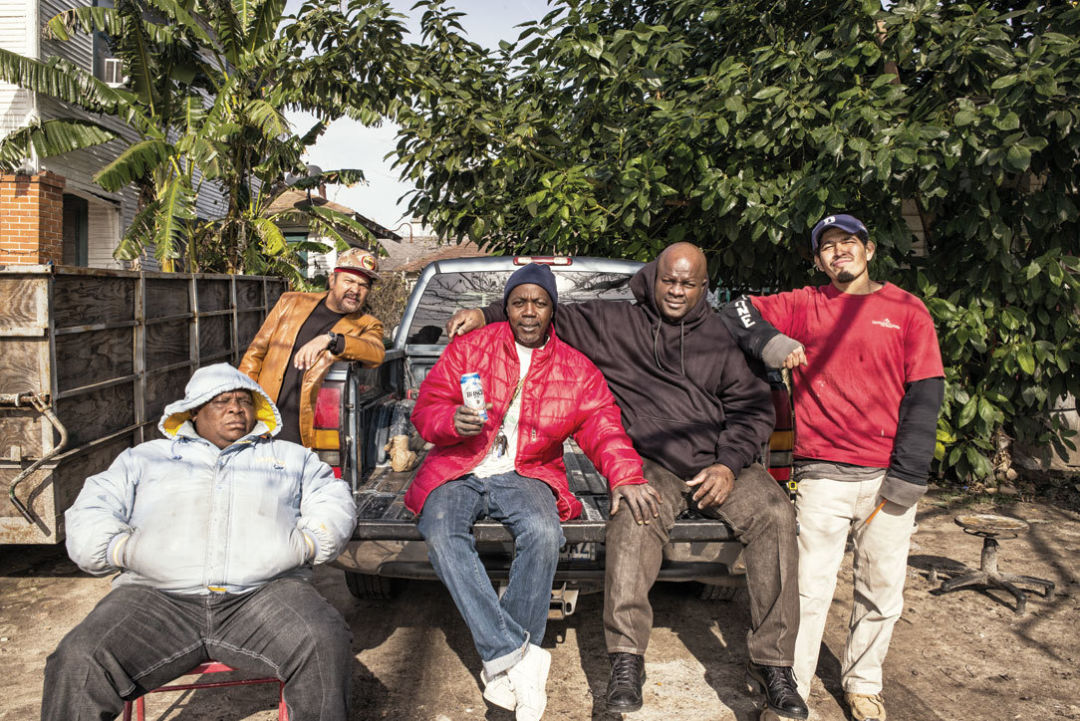
Tyrone Griggs
Resident
Tyrone Griggs sat on the tailgate of a pickup at the corner of Holman and Hutchins St., drinking a Busch tall boy and talking with a few friends about all the changes in the neighborhood. “It’s gentrification—that’s the word,” he said, pointing across the street at a hulking townhouse complex. Over the past five years, he said, many local residents, squeezed by rising property taxes, have sold their homes to developers and moved out of the neighborhood. “That’s what’s happening to the Third and Fourth and Fifth Wards. Gentrification. That’s the story.”
Griggs’s friend Edgar, a stocky 62-year-old with a vintage Rockets cap over a red do-rag, chimed in. “This is the hood, man. The hood’s always going to be the hood. You understand? I’m not knocking nobody—you can come stand by me any day you want to. We ain’t got nothing against nobody. But this is Holman Street, and Holman Street is going to be Holman Street. They’re trying to make it into Midtown, but it’s still going to be Third Ward. Back in the day, [white people] wouldn’t be allowed around here.”
“A year from now, we won’t be allowed around here if things keep up like this,” Griggs laughed, taking a sip of beer. “There’s a lot of history in this neighborhood. The Eldorado Ballroom is around the corner. On Dowling, they just put up a historical plaque for Lightnin’ Hopkins.” When asked about relations between the neighborhood and the police, Griggs said the cops mostly leave him and his friends alone.
“They don’t bother us around here, because they know we don’t do nothing but drink. Hell, the cops don’t make a whole lot of money. Five years from now, they’re probably going to wish they could live here. That’s the way it is: money talks, all that other shit walks. Gentrification—that’s what I keep saying.”
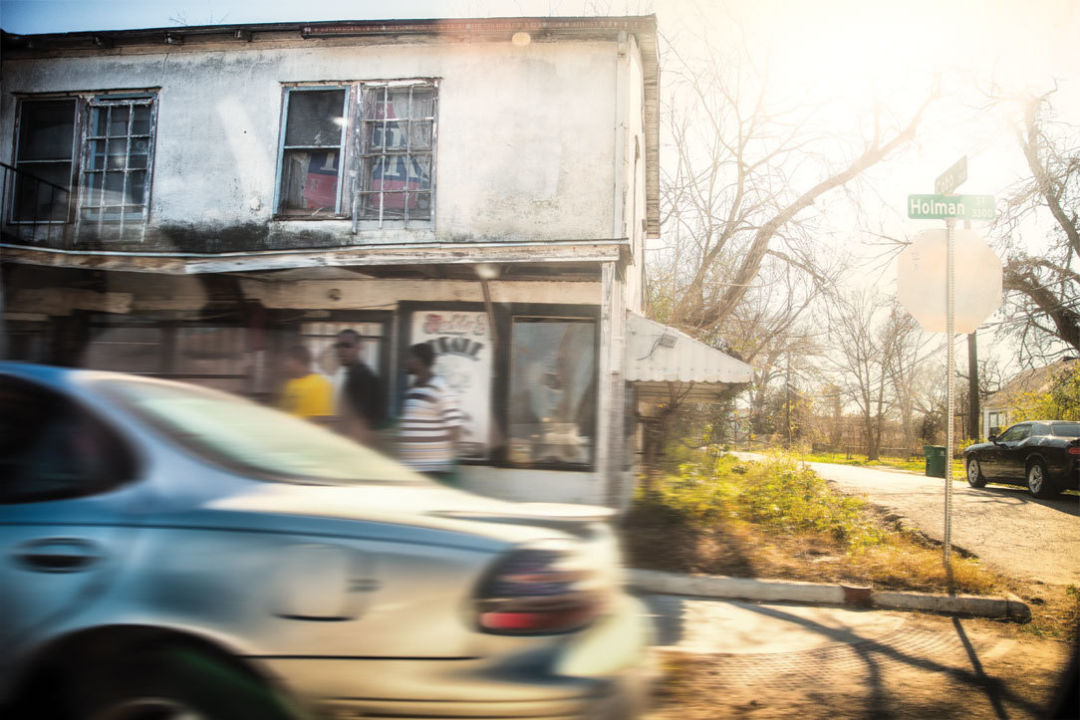
Corner of Holman and Cobb St.
Tuesday Afternoon
Woman: This place has changed. We’ve been here 14 years, and then it changed in the last few years. It used to be nice out here. Everybody got along, everyone knew each other. We never had no problems because all the old people had been here a long time. But they died off. Now they got all these youngsters coming from everywhere selling dope. And we got a problem with that now. We can’t get the law to do nothing. We call them, they come out, and once the law leaves they’re back. So I’ve been calling the City Council to see if they can help us.
Man 1: There’s no infrastructure here to make life more appealing. The only thing around here is Yates [High School] and TSU, and their main concern is growth on the campuses. There’s only one major grocery store in a 10-square-mile area over here. One. You got to put things in a neighborhood that make it appealing. A lot of these people been living here 30, 40 years, they don’t own their homes. They’re still paying rent.
Woman: Two weeks ago, I’m in my bedroom and they started shooting. Bullets was coming from all around. I had to get down on the floor, I was calling 911. The police could hear the shots over the phone. [They were] just riding around randomly, shooting, and I was praying, please don’t let no bullet come through my bedroom. It was daytime—10 o’clock in the morning. And if you tell them something, they threaten you. I’ve been threatened—a guy pulled a gun on me in my front yard. And I called the police. The policeman told me, ‘Do you own a gun?’ I said, ‘Yes sir.’ He said, ‘Well you do what you got to do. If he threatens you again, shoot him.’ All because I asked them to stop selling drugs on my porch.
Man 2: Ninety percent of the [convicted criminals] here, they served their time, paid their debt to society, but still can’t get a job. So what do you expect them to do? I ain’t taking up for them, but it’s the truth.
Woman: And they wonder why people commit crimes. It’s because they’re broke. They got to take care of their families.
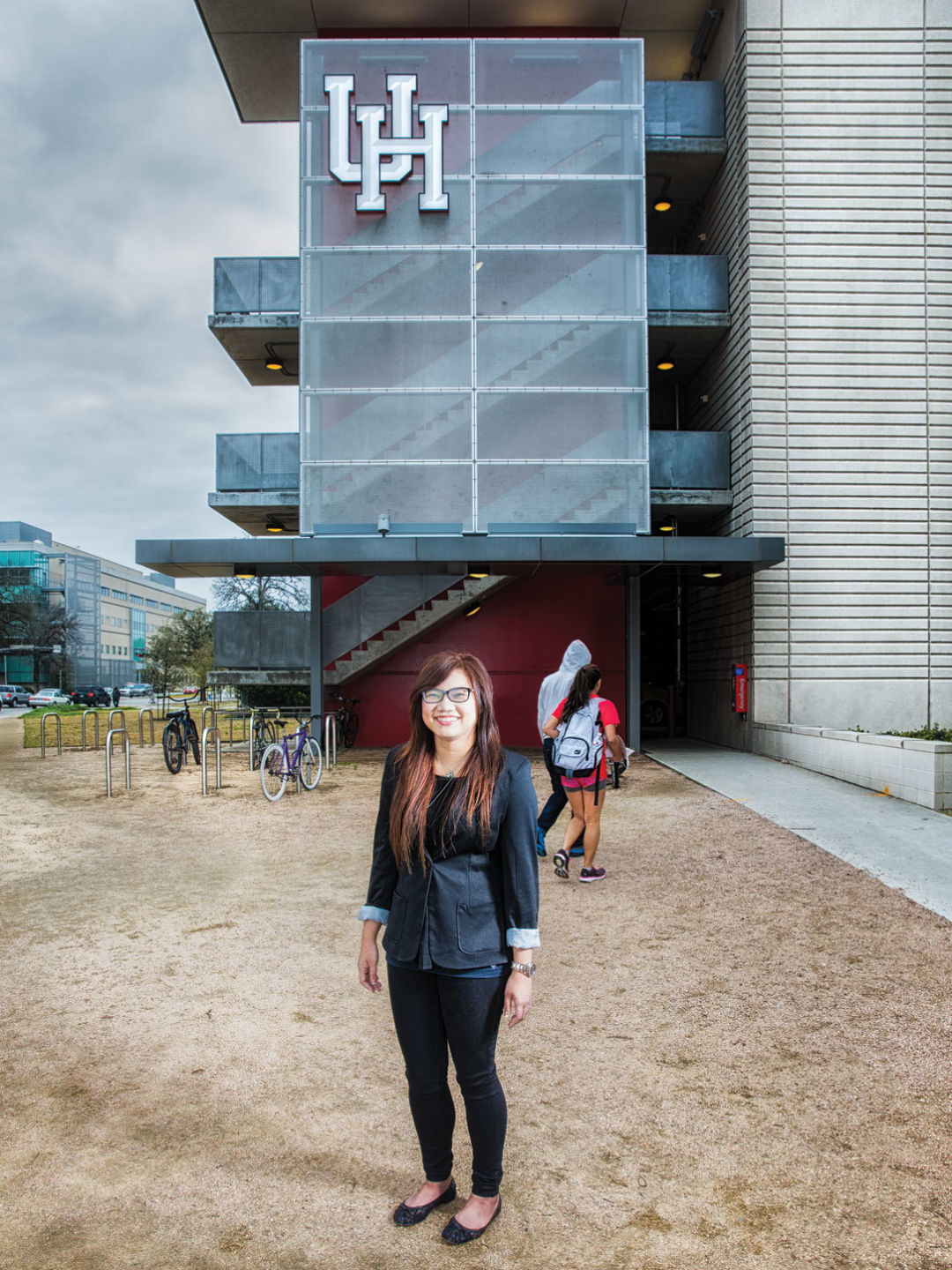
Angela Ho
Student
Standing at the corner of Holman and Cullen Blvd., UH’s ongoing metamorphosis is everywhere you look. There’s a spiffy new parking garage with fast food restaurants on the ground floor, including an outdoor patio accented by a grove of palm trees. Across the street, construction workers pour concrete for a 53,000-square-foot practice facility for the men’s and women’s basketball teams. The closest stop on the METRORail’s new Purple Line, which connects the campus to the East End and Downtown, is just a few blocks west. Looming over the whole area is the new black and red TDECU Stadium, visible for miles in every direction.
Sophomore chemistry major Angela Ho lives just around the corner from here, in the 800-unit Cougar Place student housing complex, which opened in 2013. UH is in the midst of expanding its undergraduate population, currently around 41,000, with the goal of housing 25 percent of them on campus—a major shift for the traditionally commuter-focused school.
Ho, who grew up in Brenham and won a merit scholarship to UH, said she never considered living off-campus. She volunteers with Cougar Place Cares, her dorm’s community service group, painting homes in the Third Ward and performing other charitable work. Although not a big sports fan, she attended every UH home game last year at the new football stadium, just a stone’s throw from her four-person suite.
“I like to sleep in a lot—I’m not going to lie,” she said. “So living close to everything on campus is definitely a blessing. No traffic. The biggest complaint I have is when the elevator breaks down.”
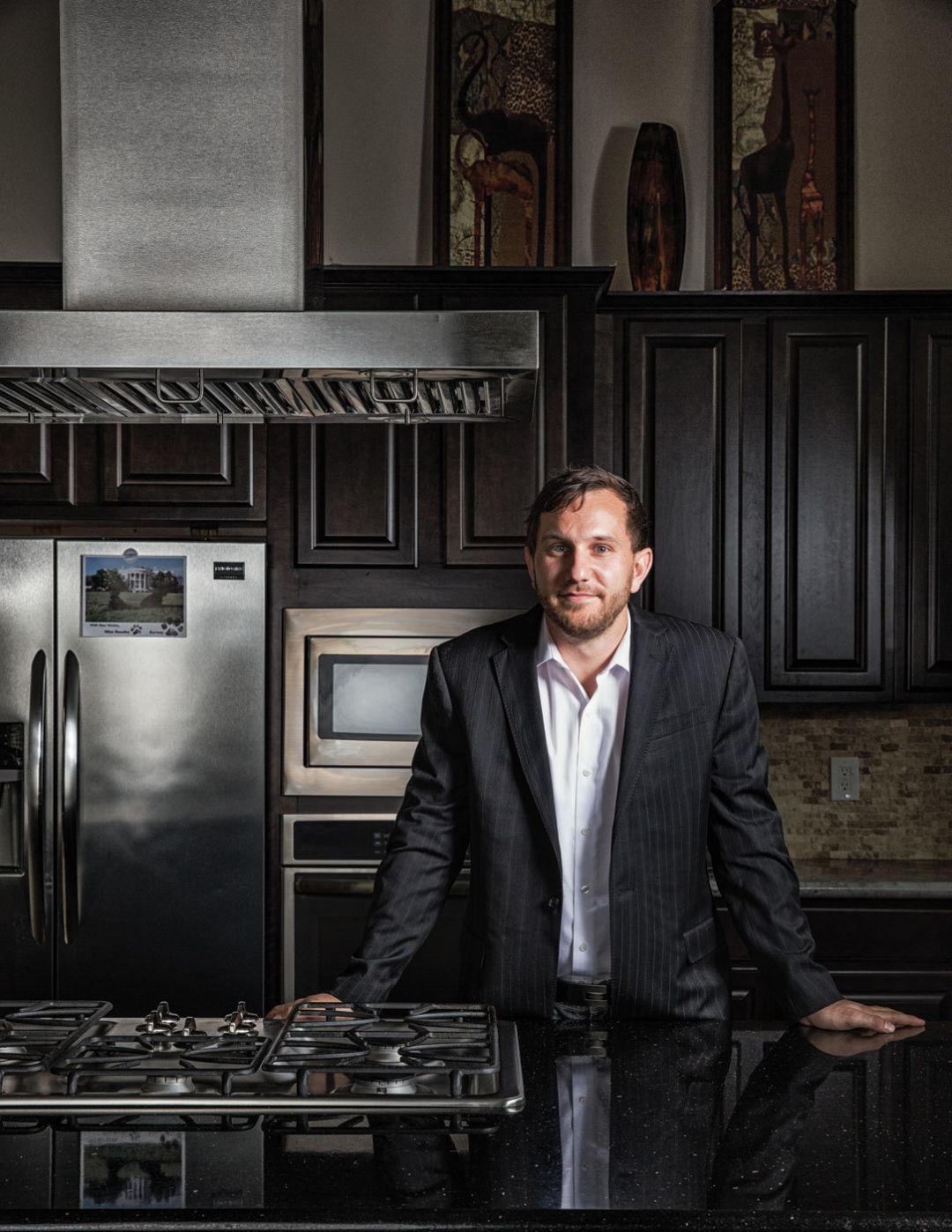
Bryan Brown
Developer
Bryan Brown’s office, a converted shipping container, sits in the middle of an empty lot he owns on the corner of Francis St. and Hutchins St., about a block from Holman. Inside, the container is equipped with a desk, a computer, a few folding chairs, and a space heater. On a recent afternoon we found Brown hunched over a blueprint, pointing out the luxe features of his new townhouse development. He wore a UH T-shirt, a UH windbreaker, and a UH hat. His mousepad and a nearby beer koozie were both emblazoned with the UH logo.
Although just 26 years old, Brown is one of the most successful developers in the Third Ward, with three completed townhouse developments within a few blocks of his office and 10 more on the drawing board. After graduating from UH in 2012—he attended on a track scholarship and wore the Shasta costume for three years as the school mascot—Brown wanted to stay in the area, so he borrowed money from both his parents and the bank and bought a townhome on the far western end of Holman with excellent skyline views. It was one of the first townhouse developments in an area blighted by condemned buildings and weed-choked lots, and he was one of the first white people to call the neighborhood home. “People told me I was an idiot for buying here,” he said. “But man, I’ve had a great time. I put a balcony on my house, and now I overlook downtown every night.” He founded a Holman St. fantasy football league, and in the summer he and his neighbors hold block parties.
When a lot on nearby Francis St. became available shortly after he moved in, his parents loaned him another $70,000 to buy it. The following day, a large developer offered him $180,000 for the lot. That’s when he knew he was on to something. “I just figured, let’s try to build homes, and if it doesn’t work I’ll try something else,” he said. He secured a loan from a bank, learned how to read blueprints, taught himself basic Spanish so he could communicate with his work crew, and went into business. Before long, other developers were coming to him for advice on how to get into the market.
Brown shrugs off criticism that he’s changing the character of the neighborhood. None of his buildings have displaced local residents, he said, and most have been built on empty lots. As for demographics, he believes he’s only adding to the area’s diversity. “It’s not only been Caucasian people buying our houses, it’s been all ethnic backgrounds. This is the coolest place in the world—you have all kinds of people. You have auto mechanics, attorneys. We sold one house to a girl who works at NASDAQ, we have people who work at Schlumberger, Baker Hughes. Change is coming—you just have to embrace it.”









